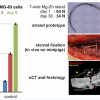Mg-Zn wires and strands
Technology description
| The name of the technology: | Mg-Zn wires and strands |
|---|---|
| Challenge: |
Magnesium (Mg) is a great candidate material for certain load-bearing implants needed in the body only temporarily. It is fully biodegradable without any adverse effects on the body, thus preventing secondary surgeries. This is its key advantage over the common material for implants – stainless ste-el. Another one is no risk of allergic or hypersensitivity reactions associated with elements contained in steel such as nickel [1]. Biodegradable polymers are another widely used material in implants, such as stents and sutures; however, their inherent poor mechanical stability in vivo, especially the loss of flexural strength, poses limitations in some applications [2]. Mg exhibits sufficient mechanical stability and biodegradability at the same time. Nevertheless, producing Mg wire with satisfactory properties remains a challenge. Pure Mg is prone to localized corrosion and can exhibit sub-optimal bending properties. To battle these challenges, complex Mg alloys are produced; however, the |
| Description: | We have mastered the production of thin Mg wire with a trace of Zn as the only alloying element. Our production setup using hot direct extrusion with an extreme reduction ratio produces Mg-Zn wire with exceptional bending capabilities [3]. Our detailed testing of the extruded Mg wires showed that even pure Mg metal is capable of bone-support applications [4]. The addition of Zn leads to a further increase in wire tensile strength while maintaining the bending properties and limiting the hydrogen generation, a common problem with Mg in body environment [5]. Detailed in vitro studies on MG-63 cells did not reveal any cytotoxicity of used Mg-Zn alloys. The coating of wires with a biodegradable co-polymer provides additional possibilities for surface functionalization and controlled drug delive-ry. The possibility of stranding the wires into different types of products provides an additional risk management measure in case of premature degradation of one wire due to an increased local corrosi-on rate. Initial tests of one intended application (sternal fixation) were conducted in vivo on minipigs with promising results. |
| Commercial opportunity: |
The magnesium wires, strands and ribbons can find applications as materials for various medical de-vices, such as cerclage wires, sutures, stents and artery bandings. Applications may include the use of wires and ribbons as reinforcement of phosphate-based bone cements. The extensive know-how of magnesium processing could contribute to the development of biodegradable K-wires. |
| IP protection status: | |
| Development status: |
Phase 3Corresponds with TRL 5 and TRL 6 Technology validation and implementing it in real environment. Testing the technology outside of the laboratory and its adjustment to external conditions.
|
| Partnering strategy: | Collaboration licensing |
| More information: |
References: [1] T. T. Roberts, et al., JAAOS - J. Am. Acad. Orthop. Surg. 25 (2017) [2] A. Bezrouk et al., PLoS One. 15, e0235842 (2020) [3] A. Ja ger, S. Habr, K. Tesar , Mater. Des. 110, 895–902 (2016) [4] K. Tesar et al., Trans. Nonferrous Met. Soc. China. 30, 373–381 (2020) [5] K. Tesar , K. Balí k, Mater. Today. 35, 195–196 (2020) |
| Images: | |
| Categories: | |
| Owner of a technology: | Martina Plisová |

